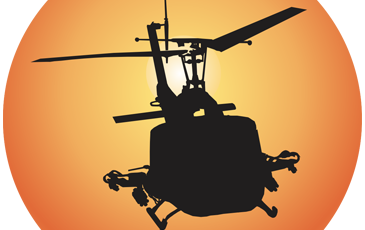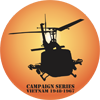High Price at the Market - Battle of Gia Binh - Campaign Series Vietnam 1948-1967

 0 - 0 - 0
0 - 0 - 0

| Rating: | 0 (0) |
| Games Played: | 0 |
| SM: | 3 |
| Turns: | 15 |
| Type: | Stock |
| First Side: | US |
| Second Side: | N. Vietnam |
Jason Petho
2 July, 1967
[Gia Binh, Quang Tri Province, South Vietnam]: [SIDE A] [HIS] [CSL]:
Since late 1966, Marines had been fighting the People's Army of North Vietnam in the area around Con Thien (translated as "Hill of Angels"). Prior to May 1st, 1967, the hill was defended by ARVN troops, later being taken over by the U.S. 9th Marines.
The Marines along the DMZ began construction of the strongpoint obstacle system south of the border in the spring and fall of 1967 in compliance with orders from MACV and Washington. The system, called the "McNamara Line" by the Marines, proved to be a major burden to the 3rd Marine Division.
Security of the troops building the line, coupled with the demands on Marine units to fill sandbags, creosote bunker timbers, install wire, and other associated tasks, severely restricted the division's combat activities.
The Marines' combined-arms fire power from strong points would then confront the anticipated PAVN attacks. Smaller patrols and infiltration groups would face the challenge of the extensive obstacle system.
The PAVN, however, chose to attack before the system became too strong. The PAVN decided to concentrate on the Marine strong point at Con Thien, located 22 kilometres inland and three kilometres south of the DMZ.
This outpost was crucial to Marine efforts in the area, as it occupied the northwest corner of the strong point obstacle system, which enclosed an area known as "Leatherneck Square." Con Thien also overlooked one of the principal enemy routes into South Vietnam.
The capture of the outpost would open the way for a major enemy invasion of Quang Tri Province by 35,000 PAVN troops massed north of the DMZ, a victory of immense propaganda value.
The first offensive aimed at Con Thien, the largest in terms of troops committed, occurred in July. For the first time the PAVN employed extensive artillery to support its infantry, but the Marine counterattack, Operation Buffalo, beat them back with excessive casualties.
Operation Buffalo began on July 2nd utilizing the 1st Battalion, 9th Marines in and around Con Thien. Companies A and B operated north and northeast of the strongpoint near a former marketplace on Route 561, while Company D and the battalion command group remained within the outpost perimeter.
On the morning of 2 July, Alpha and Bravo Companies, 1st Battalion, 9th Marines made their way up north on Highway 561 and secured a crossroad as their first objective.
As they advanced further north between Gia Binh and An Xa, near a marketplace, they made contact with advance elements of two battalions of the PAVN 90th Regiment when sniper fire began to break out, enemy fire intensified as efforts were made by the 3rd Platoon to suppress it.
Tri-directional ambushes caught B/1st/9th in a quagmire of fire. The battle that followed is where the 1st/9th Marines would acquire their nickname, "The Walking Dead".
[ALL, NO VV] [CSEE, Variable Objectives] [1.00]
2 July, 1967
[Gia Binh, Quang Tri Province, South Vietnam]: [SIDE A] [HIS] [CSL]:
Since late 1966, Marines had been fighting the People's Army of North Vietnam in the area around Con Thien (translated as "Hill of Angels"). Prior to May 1st, 1967, the hill was defended by ARVN troops, later being taken over by the U.S. 9th Marines.
The Marines along the DMZ began construction of the strongpoint obstacle system south of the border in the spring and fall of 1967 in compliance with orders from MACV and Washington. The system, called the "McNamara Line" by the Marines, proved to be a major burden to the 3rd Marine Division.
Security of the troops building the line, coupled with the demands on Marine units to fill sandbags, creosote bunker timbers, install wire, and other associated tasks, severely restricted the division's combat activities.
The Marines' combined-arms fire power from strong points would then confront the anticipated PAVN attacks. Smaller patrols and infiltration groups would face the challenge of the extensive obstacle system.
The PAVN, however, chose to attack before the system became too strong. The PAVN decided to concentrate on the Marine strong point at Con Thien, located 22 kilometres inland and three kilometres south of the DMZ.
This outpost was crucial to Marine efforts in the area, as it occupied the northwest corner of the strong point obstacle system, which enclosed an area known as "Leatherneck Square." Con Thien also overlooked one of the principal enemy routes into South Vietnam.
The capture of the outpost would open the way for a major enemy invasion of Quang Tri Province by 35,000 PAVN troops massed north of the DMZ, a victory of immense propaganda value.
The first offensive aimed at Con Thien, the largest in terms of troops committed, occurred in July. For the first time the PAVN employed extensive artillery to support its infantry, but the Marine counterattack, Operation Buffalo, beat them back with excessive casualties.
Operation Buffalo began on July 2nd utilizing the 1st Battalion, 9th Marines in and around Con Thien. Companies A and B operated north and northeast of the strongpoint near a former marketplace on Route 561, while Company D and the battalion command group remained within the outpost perimeter.
On the morning of 2 July, Alpha and Bravo Companies, 1st Battalion, 9th Marines made their way up north on Highway 561 and secured a crossroad as their first objective.
As they advanced further north between Gia Binh and An Xa, near a marketplace, they made contact with advance elements of two battalions of the PAVN 90th Regiment when sniper fire began to break out, enemy fire intensified as efforts were made by the 3rd Platoon to suppress it.
Tri-directional ambushes caught B/1st/9th in a quagmire of fire. The battle that followed is where the 1st/9th Marines would acquire their nickname, "The Walking Dead".
[ALL, NO VV] [CSEE, Variable Objectives] [1.00]





















